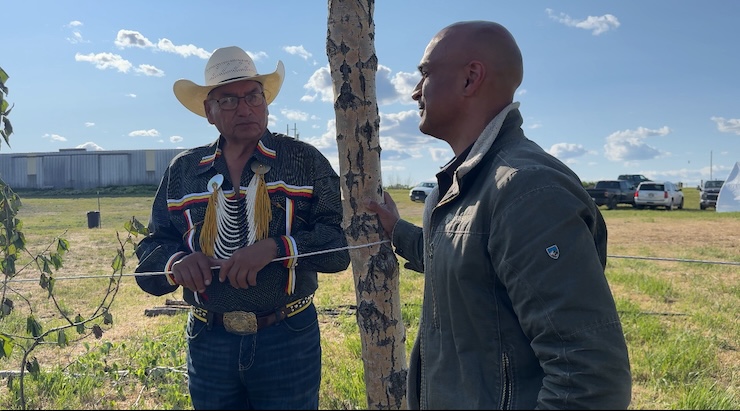We have raised more than 40 heritage buffalo, and actively release them to the care of the people of the Blackfeet Nation in Montana.
Bison, North America's largest land mammals, play a crucial role in shaping the biodiversity of America's Northern Plains, which have suffered from more than a century of degradation and loss of wild lands. The Rocky Mountain Front in the traditional territory of the Blackfeet people offers some of the last habitat in our country where wildlife can roam free. Sadly, despite being so important to this prairie ecosystem and America's cultural history, bison ("Iinnii" in the language of the Blackfeet) are still missing from this landscape, after being nearly driven to extinction in the late 1880s. Oakland Zoo has joined forces with several conservation organizations to restore heritage bison to the landscape of the Blackfoot Confederacy, sustain Blackfeet culture, and create a lasting homeland for this iconic creature. “These animals are culturally and spiritually connected to our people and I believe their homecoming will begin a healing of historical trauma to the Blackfeet people.” -Ervin Carlson, President of the Intertribal Buffalo Council

Just two centuries ago, between 30 and 60 million bison roamed North American grasslands. But by the late 1800s, sport hunting and mass slaughter brought the bison to the brink of extinction. In 1906, only about 1,000 bison, wild and captive, remained. Thanks to strong conservation efforts in the early 20th century, the bison population has grown to about 450,000. However, fewer than 20,000 of these animals range freely and many have been crossbred with cattle or other bison subspecies.
Bison play an important role in the history and culture of Native Americans, including the Blackfeet people. The mass slaughter of bison was culturally devastating for them - not only did bison provide food and other crucial materials needed for survival on the prairie, but the loss of this iconic animal also severed the spiritual connection to wildlife and the land. According to Harry Barnes, Blackfeet Tribal Business Council Chairman, “The elders have long believed that until the buffalo returned, the Blackfeet Tribal Nation would drift.”

Ervin Carlson, Director of the Blackfeet Buffalo Program, speaking with Oakland Zoo CEO Nik Dehejia in Browning, Montana

Adult and bison calves at Oakland Zoo
Adult and bison calves at Oakland Zoo
Oakland Zoo aids in increasing the wild population of North American bison through an outbreeding and release program. This partnership allows new genes to intentionally be integrated into buffalo herds. Buffalo are brought to the zoo’s rolling hills habitat to roam and breed with the zoo’s bison population. Once old enough, offspring are returned to the Blackfeet tribal lands to roam freely. In 2016, Oakland Zoo, WCS, and the Blackfeet tribes began this partnership. The agreement allowed 88 Bison from Elk Island National Park in Canada to be relocated to their ancestral lands on the Two Medicine River, in Browning, Montana. Oakland Zoo selected 11 animals from the herd to be part of the outbreeding program. Today, Oakland Zoo partners with INDIGENOUS LED; the ultimate goal is for descendants from the new blended herd, including calves born at the zoo, to supply further restorations on wild landscapes in the Blackfeet Territory. The resurgence of bison where they have been absent for a century will greatly benefit the prairie ecosystem and other wildlife as well.
Oakland Zoo aims to use our access to the public to help wildlife. We are enthusiastic about the return of bison to Blackfeet tribal lands, and we show this by sharing knowledge about this charismatic species and its rich cultural heritage.
Oakland Zoo will assist the Blackfoot Confederacy with the cultivation of ecotourism programs. These profitable experiences will help create nature-based, sustainable jobs and a solid learning connection between bison and the Blackfeet Nation heritage. Our vision is to host Oakland Zoo Nature and Heritage Expeditions to Montana and Glacier National Park.

A conservation movement created to face three interconnected crises: the loss of biodiversity, the destabilization of our climate, and the urgent need for justice; rooted in relationship and Indigenous ways of knowing.

In Glacier National Park, the mighty grizzly bear travels through the landscape, alone or with cubs, foraging for food, searching for mates, and seeking new territories. These threatened bears, along with pumas, mountain goats, and others, need protected wildlife corridors to successfully pass under the busy roads of this popular national park. GNP is dedicated to the conservation of the grizzly bears that call this park their home, and aims to find solutions through scientific research and action.

WCS spearheaded an American Bison Society initiative to help build the social and scientific foundations for the ecological restoration of bison. Their dedication to the Iinnii Initiative and the landscapes of Glacier National Park are paramount to our shared vision.

Zoo-Park Partnerships (ZPPs) help America recover the wildlife legacy lost during Westward Expansion era of U.S. history and improve wildlife population health, genetic integrity and habitat in ways that also benefit local communities on public lands today. ZPP helps Glacier National Park and Oakland Zoo strengthen their relationship, ultimately benefit bison and all animal in this shared habitat.